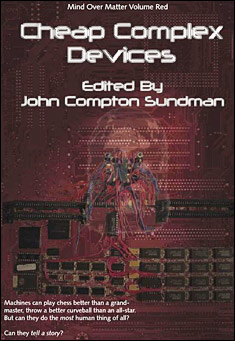Computers can play chess as well as any grandmaster. They can diagnose cancer as well as any oncologist, find oil as well as any seismologist. But can they do that most human of all activities: can they tell a story? Read Cheap Complex Devices and find out.
Cheap Complex Devices is a book comprised of (A) a note by the editor, John Compton Sundman (B) an introduction to the Hofstadter Competition, written by the Committe on Computer-Written Novels of the Society for Analytical Engines, (C) the computer-written novel entitled "Bees, or The Floating-Point Error," and (D) the computer-written novel called "The Bonehead Computer Museum."
Excerpt:
Bremser moves to Walli Diallo, a tiny landlocked country in the Sahel, the fringe of the Sahara, where Arab Africa meets Black Africa and desert gives way to savannah. Fifteen years ago, when he was 21, he had worked here doing agricultural development projects for Catholic Relief Services. But after a traumatic incident he had returned to the States, where he became a computer expert specializing in the design of numerical subsystems.
Now Bremser has gone back to Africa. He is working at a research station called Tianga Farm, where he is using both his agricultural and computer experience. It’s an irrigated farm out in the middle of nowhere, a ten-square-mile island of green at the edge of a shallow river that flows through an ocean of sand. The national government operates an experiment station at Tianga and leases parcels of land to peasant cooperatives. There is an earthen dike about fifteen feet high that encircles the farm to protect it from the floodwaters of the Walli Diallo river, which has its headwaters in the mountain jungles a thousand miles to the south. But now it is dry season, and the dike protects the farm only from nothingness. Bremser is walking along the dike at sunset as the story begins.
Some Peulh nomads walk in from the Sahara bearing the message that Ismaila M’Bodj wants Bremser’s help. Bremser remembers Ismaila well, but had thought he was long dead. Fifteen years ago, in the confusion of an anti-American coup, Ismaila had saved Bremser’s life by offering himself as a hostage in Bremser’s place. The last time Bremser had seen Ismaila he was being marched away at gunpoint. Bremser is overjoyed to learn that his friend still lives.
So Bremser now heads off on what he thinks will be a week-long trek. He ends up walking for nearly three months, north by east, be-ing passed like a token from one group of nomads to another, until the dunes of the Sahara yield to rugged dry mountains.
After weeks of scrambling through ravines and over ridges, the party arrives at the end of deep narrow canyon with walls five hundred feet high. Atop the east wall there appears to be a castle-like stone building, apparently ancient. In a tiny settlement of mud and thatch huts at the very end of the canyon Bremser finds his old friend Ismaila and an eccentric American named Ted.
Ted is wild-eyed and unkempt; his hair is long and matted, and he wears a smock of coarse cloth. He eats insects and wild honey. He rants like a crazy person about technology, sin, repentance, and the One who is to Come. He apparently believes that Christ’s return is right around the corner. Bremser learns Ted’s history:
For eight years Ted had worked in the “R” group at the Livermore National Laboratory, where he designed advanced weapons such as hydrogen bombs and x-ray lasers. Despite his intense efforts at the laboratory he had been growing increasingly ambivalent about his work there. Then one day his girlfriend was run over by a train outside the Laboratory in a “Star Wars” protest and something in-side him snapped. By chance he met Ismaila, himself traumatized, and together they decided to form New Sanctuary, a utopian place at the far end of the world.
By the time Bremser shows up, Ted and Ismaila have been working at their New Sanctuary for nearly a decade. A small cadre of followers has assembled around them. Some are European, some are African. All they want is for the advanced world to leave them in peace. But The World is encroaching. International Vision, Inc, has just put a geosynchronous television relay satellite into orbit right over New Sanctuary. Night after night, as countless other satellites quickly zoom across the impossibly clear heavens, the orange point of International Vision, Inc., hangs immobile over New Sanctuary, like the star over Bethlehem. (Incidentally the satellite scans for signs of oil directly underneath it.) Ted, the prophet of New Sanctuary, has decided that they must act now. They have the right to look up into the heavens without seeing somebody’s space junk. They want an end to satellites cluttering up their sky at night; they want an end to TV beaming down into the villages of Walli Diallo, where an increasing number of teenagers are watching it on televisions powered by solar generators. Nobody asked New Sanctuary’s per-mission to overfly them, and they’re not giving it. They consider the transmission of television messages that promote consumerism to be an act of war. Ted, Ismaila and Company have decided to shoot all the satellites out of the sky.




